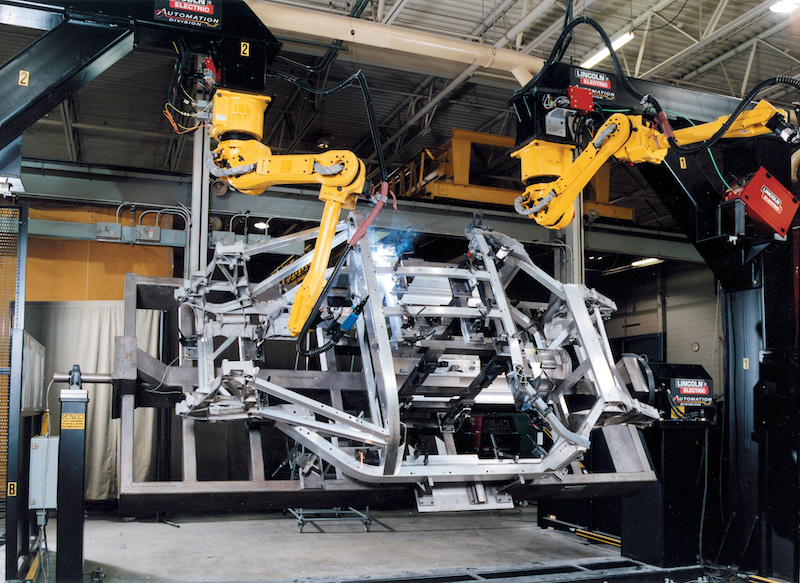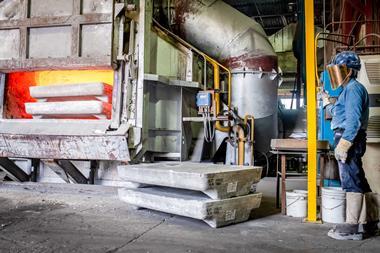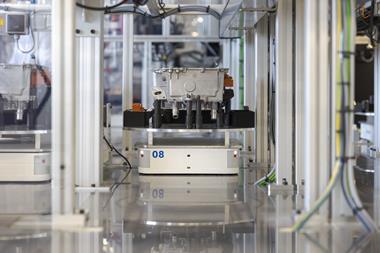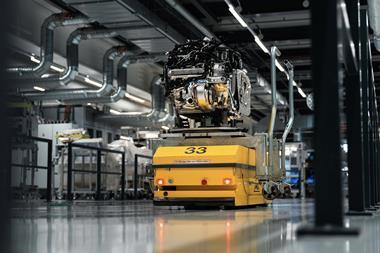
In an industry where everyone is looking for a more efficient vehicle, OEMs have started shifting their focus to aluminium as their material of choice, writes Lincoln Electric’s Mikael D. Carriere
The use of aluminium has continuously grown in the automotive industry in the last 40 years and it has recently become far more efficient to use. However, it brings additional challenges, even as manufacturers become more educated and experienced with the material. Furthermore, companies must always be seeking opportunities to reduce cost and be competitive in the ever-evolving business of automotive manufacturing.
Saving money is not always spearheaded by the supply chain or accountants, it is also a large function of manufacturing engineering; streamlining products, reducing bottlenecks, reducing downtime, minimising non-value-added operations and integrating automation into the manufacturing process are all paths to efficiency. This article looks at aluminium welding operations and provides options to increase productivity and efficiency.
Reducing downtime, increasing productivity
Downtime is always very costly for manufacturing companies, but even worse for high-output factories such as those in the automotive industry. Welding downtime can stem from many different process failures, such as feeding issues, wire shavings and not using efficient wire consumables for aluminium.
Feeding issues
Aluminium, being very soft, can cause feeding issues more than materials such as steel. Accordingly, there are many different parts used for feeding aluminium wire while welding that differ from welding steel. It is important to acknowledge the differences and to ensure feeding systems have the proper equipment for welding aluminium specifically. Try to eliminate or reduce the amount of steel parts within the feeding system (these being mainly wire guides and liners). U-groove drive rolls and aluminium-specific contact tips are required. Furthermore, use the largest diameter wire possible or practical for the job, as this increases wire stiffness, reducing the likelihood of a feeding issue.
The path of the conduit that directs the wire from the wire package to the feeder can also create a feeding issue. Keep the distance from the package to the feeder as short as possible. Also, while programming the robot, sometimes ‘tunnel vision’ can affect the feeding performance. While programming a robot, some programmers are prone to focusing on the wire coming out of the contact tip – make sure that work and travel angles are optimal as well as that contact-tip-to-work distances are kept consistent. If the path of the conduit is left unnoticed, there often can be sharp bends which increase the resistance of the wire moving through the liner and can inhibit constant and consistent feeding. Stand back and observe the robot’s position at each point and watch its movement during the dry run to ensure that the conduit does not end up in any positions that could cause a pinch in the wire, or sharp angles that would increase the feeding resistance.
Shavings
Aluminium wires (mainly larger diameter 5xxx series) can create aluminium shavings within the liner. Accumulation of these shavings will create a densely packed portion in the liner, affecting wire feeding. Pre-maintenance should be performed regularly on the liner and feeding system. However, pre-maintenance is just another word for downtime. Make sure to use a good quality wire with a smooth surface like Lincoln Electric SuperGlaze, which has been surface treated to reduce shavings from the liner in 5xxx series wires. This increases contact tip and liner life and reduces the need for the regular preventative maintenance to be done on the gun.
Bulk packages
Bulk packages are used in high-productivity environments to reduce the amount of downtime incurred by switching over from one spool to the next. However, feeding bulk-packaged aluminium welding wire can be a difficult task. Because of how active the wire is, it tends to tangle much more often than other materials. Lincoln Electric designed an innovative bulk package, Gem-Pak, which was developed to virtually eliminate tangling using a unique process operating with glass gems. Being able to eliminate tangles also eliminates any re-work associated to wire tangling.
End users who switched to using the Gem-Pak reported that the biggest savings were associated with productivity. While using an alternative product it was noticed that by reducing the wire feed speed the amount of tangles that would occur decreased. By switching to the Gem-Pak they were able to increase wire feed speeds and travel speed, and therefore decrease the cost of welding. One user that changed the product to Gem-Pak reported the following results: a 12.5% increase in productivity; a 3% decrease in rework; and a 50% reduction in contact tip usage and liner usage. For this automotive end user, the results of the successful implementation resulted in an annual saving estimated at $722,983.61.

Securing a supply
Another factor in reducing downtime is to purchase high-quality aluminium welding wire from a manufacturer that can provide consistent supply. A vertically integrated manufacturer that starts with aluminium ingot is not subject to supply fluctuations in the aluminium rod market. Also, a dedicated aluminium welding rod producer can tailor the chemistry to provide the best welding performance. A trusted supplier eliminates the risk of running out of product and causing downtime. Lincoln Electric is the only aluminium welding wire supplier with a fully integrated manufacturing facility that is capable of making aluminium rod, which is the starting point for producing aluminium weld wire.
Switching from GTAW to GMAW for repair stations
GTAW (gas tungsten arc welding) is a process that is typically executed manually, whereby the welder has complete control of current through a foot pedal or similar device and deposits the filler rod manually. The arc is established between a tungsten electrode and the base material.
GMAW (gas metal arc welding) uses a gun or torch with welding wire instead of rod. The welder presses the trigger on the gun and the wire feeds out of contact tip. Current is controlled by the set wire feed speed and the deposition is constant. The arc is created between the welding wire and the base plate.
While aluminium welding is sometimes performed using the GTAW process for the aesthetics and the higher quality weld that is produced, many times it can be replaced by the much more efficient GMAW process. The starting of GTAW welds can be fused properly without a cold start or lack of penetration. Instead, a GMAW process can be used, and lack of fusion at the beginning of the weld can be avoided by using run-on and run-off tabs, and reduced by using a starting procedure (“hot start”).
GTAW welds tend to have less porosity within them. However, it should be understood that most codes have an allowable amount of porosity. GMAW can be used for all code acceptance criteria if applied properly. Although the benefits of GTAW as noted above can be advantageous in some manufacturing practices, they come at a cost of high operator wages and low manufacturing efficiencies, such as travel speeds. If a GTAW process is being used strictly for aesthetics, it may be possible to substitute a GMAW process with modified pulse waveforms that have been created to help mimic the bead appearance of GTAW.
Conclusion
There are many different ways to save money while welding aluminium in the automotive industry, several of which were reviewed here. By identifying and preventing the issues that cause down time and by using efficient consumables, productivity can be increased resulting in a more cost-effective process.

































